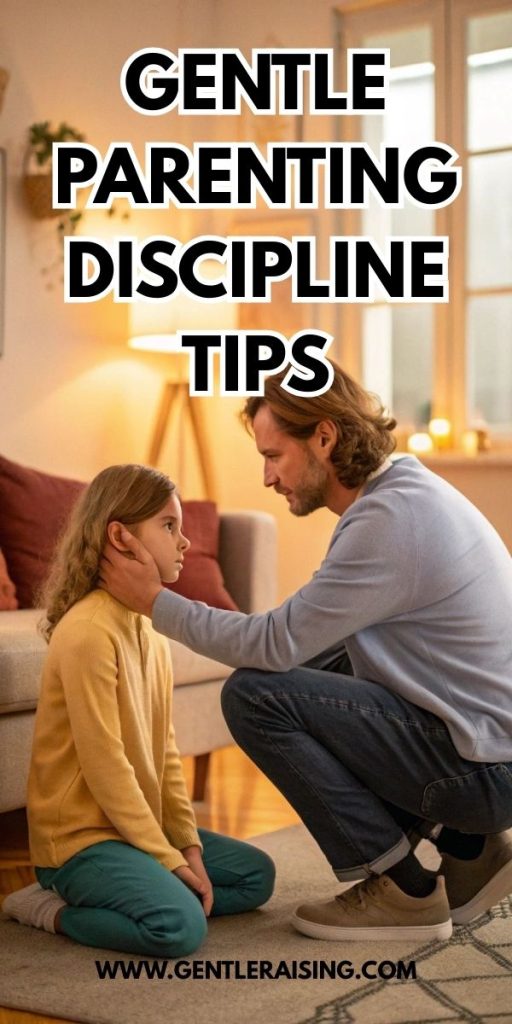Why Discipline Doesn’t Have to Mean Punishment
If you’re a parent, especially a new one, you’ve probably had those late-night moments where you wonder: Am I being too soft? Too strict? Too inconsistent? You’re not alone. Many of us grew up with a very different picture of discipline: raised voices, threats of punishment, sometimes even spanking. For a long time, discipline was practically synonymous with punishment.
But here’s the thing, discipline at its root comes from the Latin word disciplina, which means teaching. And that’s the heartbeat of gentle parenting: teaching rather than controlling, guiding instead of punishing.
So if you’re searching for gentle parenting discipline tips or wondering how to discipline toddlers gently without losing your mind, you’re in the right place.
What Gentle Parenting Really Means
First, let’s clear up the big misconception: gentle parenting does not mean letting your child do whatever they want. It’s not permissive, lazy, or hands-off.
Gentle parenting is about:
- Respecting your child as a person with valid feelings.
- Understanding their behaviour through the lens of development, not just obedience.
- Teaching skills (like self-regulation, empathy, problem-solving) that they’ll carry into adulthood.
It’s also about you, your patience, your tone, and your consistency. And that’s why people sometimes confuse gentle parenting vs permissive parenting. The difference is boundaries. Permissive parenting lacks them; gentle parenting sets them with empathy.
Here’s a real-life scenario: your mom or dad, or maybe a grandparent, might raise an eyebrow when they see you calmly talking through your toddler’s tantrum. “In my day, a good spanking fixed that,” they might mutter. And you’re left in that awkward spot: do you defend your approach or nod along just to keep the peace? That cultural pressure is real, and it makes gentle parenting boundaries harder to maintain.
But here’s the payoff: kids raised with gentle discipline are more likely to cooperate not out of fear but out of respect and connection.
Common Misconceptions About Gentle Discipline
Let’s tackle a few myths head-on:
- “Kids will walk all over you.”
Not true. Boundaries are a huge part of gentle parenting; they’re just communicated with empathy rather than threats. - “Gentle parenting means no discipline.”
Nope. Gentle parenting is full of discipline; it just looks different. Think natural consequences, calm teaching, and consistency. - “You’ll spoil your kids if you comfort them when they misbehave.”
Actually, the opposite. Comfort builds security, and secure kids are more open to correction.
Harsh punishments often look effective because they stop behaviour quickly. A timeout, a raised voice, or a spanking can shut a child down. But in the long run, those tactics don’t teach problem-solving or self-regulation.
That’s why parents are turning to gentle discipline strategies—because they address the root cause, not just the symptom.
The Science Behind Gentle Discipline
Parenting isn’t just instinct; it’s neuroscience.
Young kids don’t have fully developed prefrontal cortices (the part of the brain that manages self-control, reasoning, and decision-making). That means your three-year-old is melting down because you cut their sandwich wrong? They’re not being manipulative; they literally can’t regulate that flood of emotion.
Here’s what research tells us about gentle parenting discipline tips in action:
- When kids are yelled at, their stress hormones (cortisol) spike. That stress response shuts down higher reasoning. Translation: they can’t learn in that state.
- Gentle parenting, with calm tones and clear boundaries, activates the brain’s learning centres. Kids remember better, regulate better, and build trust.
- Mirror neurons mean kids “mirror” what they see. Handle conflict calmly, and you’re wiring their brains to eventually do the same.
Sometimes just remembering “their brain isn’t finished cooking yet” can change how you respond to misbehaviour.
Gentle Parenting Discipline Tips (Practical and Real-Life)
Now let’s get into some gentle discipline strategies you can use right away.
1. Connection before correction.
Before correcting behaviour, connect with your child. Squat down, make eye contact, and use their name. Correction lands better on the connection.
2. Set clear and consistent boundaries.
Gentle parenting boundaries are non-negotiable but communicated with calm firmness. “We don’t hit” should sound the same at home, at Grandma’s, or in Target.
3. Name the emotion.
Try: “You’re angry because your toy broke.” This shows empathy while still holding the line. Kids learn emotional literacy from you.
4. Offer choices, but keep them limited.
Instead of “Do you want to brush your teeth?” (which invites a no), try: “Do you want the red toothbrush or the blue one?”
5. Model the behaviour.
You can’t yell at a child to “stop yelling.” Kids mimic what they see. If you want respect, show respect.
6. Lean on natural consequences.
Instead of, “You’re grounded for spilling juice,” try: “Let’s grab a towel together and clean it up.” That teaches responsibility without shame.
7. Use positive reinforcement wisely.
Recognition works better than bribery. “I noticed how you shared your to, that was kind.”
Quick example: my toddler once melted down because I poured milk into the “wrong” cup. Instead of snapping, I said, “You’re upset because you wanted the blue cup. That’s frustrating. Let’s switch it.” Result? The tantrum ended in minutes. That’s gentle parenting discipline at work.
When Gentle Parenting Feels Impossible
Sometimes you’re tired, overwhelmed, and yes, you yell. That doesn’t mean you’ve failed at gentle parenting.
What matters most is repair. Tell your child: “I was frustrated and I yelled. I’m sorry. I’ll try again.” Far from undermining authority, this teaches accountability.
It’s one of the most underrated gentle discipline strategies, showing your child how to own mistakes and make amends.
Discipline Through Different Ages
How to discipline toddlers gently:
Expect meltdowns. They’re not “bad,” they’re learning. Use redirection, distraction, and consistent routines.
Preschoolers (3–5 years): They test boundaries daily. Stay calm and consistent.
School-age kids (6–12 years): They can reason more, so natural consequences and conversations work better.
Teenagers: Gentle parenting still applies. Respectful dialogue, clear boundaries, and trust-building matter most. (Eye-rolls are developmentally normal, by the way.)
Gentle Parenting in Real Life (Messy but Worth It)
Some quick real-world scenarios where gentle parenting comes alive:
- Grocery store tantrum: “You want candy, and I said no. That’s hard.” Then move on. People may stare, but your child’s trust matters more than strangers’ opinions.
- Bedtime battles: Stick to routines, offer limited choices, and stay firm.
- Sibling fights: Teach problem-solving instead of punishment: “How can we fix this together?”
Gentle parenting doesn’t mean you never cave. It means you aim for respect and teaching more often than control or fear.
Gentle Parenting and Cultural Realities
In some cultures, spanking is still common. In others, it’s frowned upon. Extended families often pressure parents to “discipline the old way.”
Navigating these pressures is part of the journey. A simple, firm line can help: “We’re trying a different approach that works for our family.”
Gentle parenting doesn’t erase tradition; it blends cultural wisdom with modern child development science.
Tools and Resources That Help
Helpful resources for anyone practising gentle parenting discipline tips:
- Books: The Whole-Brain Child by Daniel Siegel, No-Drama Discipline by Siegel & Bryson, How to Talk So Kids Will Listen and Listen So Kids Will Talk by Faber & Mazlish.
- Podcasts: Janet Lansbury’s Unruffled.
- Communities: Facebook groups and Instagram pages for gentle parenting examples and support.
- Mindfulness apps: Headspace or Calm, to regulate your own emotions first.
Conclusion: Gentle Parenting Is a Journey, Not a Destination
Gentle parenting is about choosing teaching over punishment, connection over fear. It’s not easy. It takes patience, repetition, and grace. But it works, because kids learn best when they feel safe, respected, and loved.
So next time you wonder how to discipline toddlers gently or how to set firmer parenting boundaries, remember: you don’t need perfection. You just need consistency, empathy, and the willingness to try again tomorrow.
And honestly? You’re probably doing better than you think.

